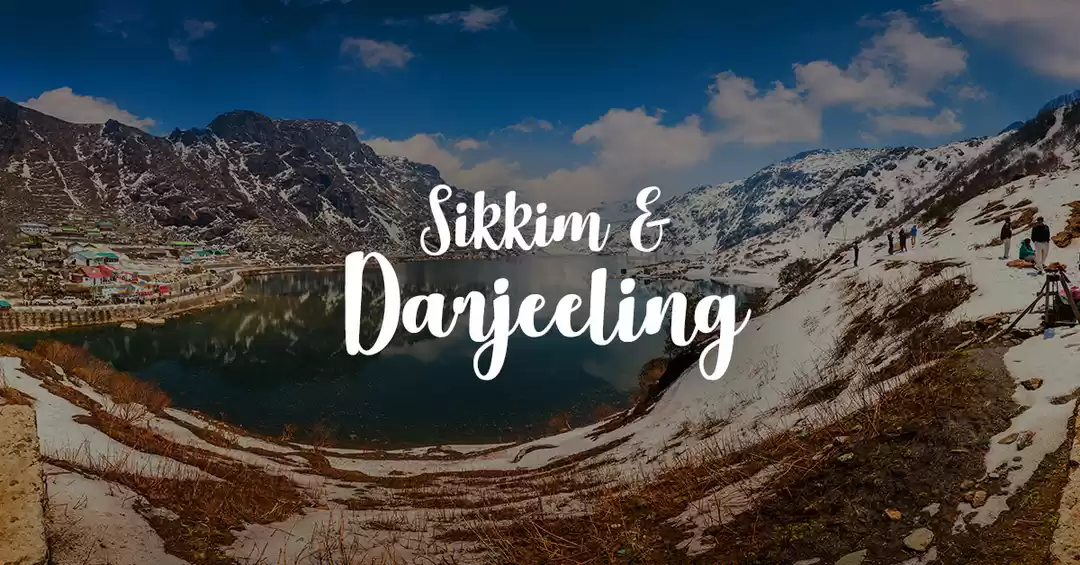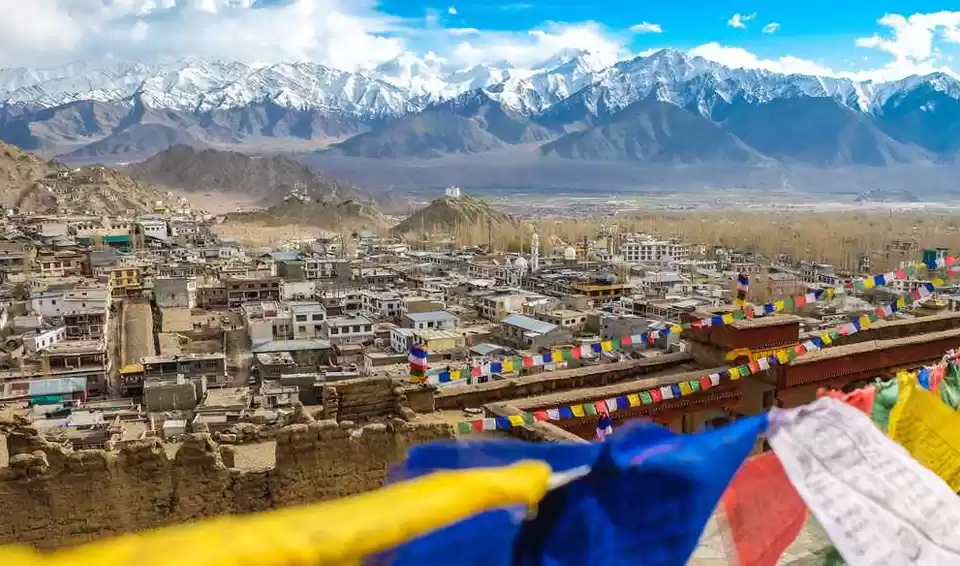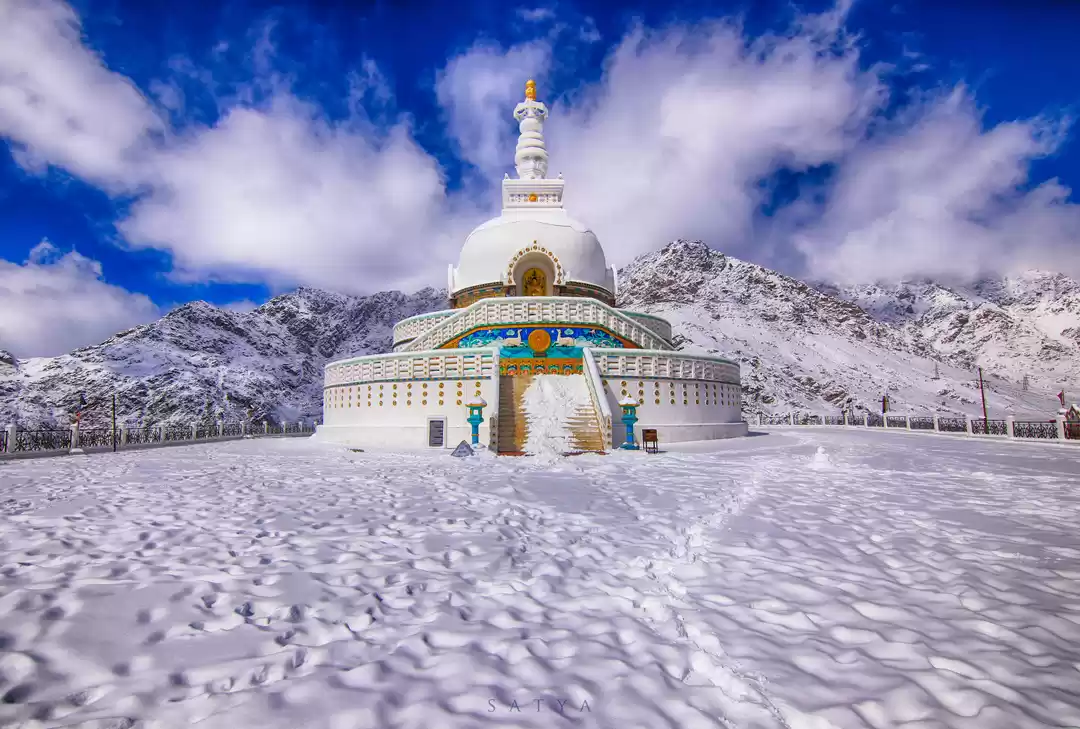



































Countless shades of blue change with the falling light, turquoise blue waters merge into cobalt blue cloudless skies, reflecting in the ripples of water with a mosaic of colorful stones shining underneath; the Ladakh Blues!
Surreal landscapes, dangerous mountain passes, colorful monasteries with gorgeous vistas and flags fluttering in the wind… Everything about Ladakh is ethereal. But if I have to choose a favorite, it would be the colors of the pristine high altitude mountain lakes. These lakes are endorheic, which means the water has no outflow to other external bodies like a river or sea. The brackish water of the lakes carry high concentrations of minerals & salts brought by the melting snow from the surrounding mountains. I got the opportunity to visit the high altitude Himalayan lakes – Tso Moriri, Tsokar, Pangong Tso and a few other smaller lakes, over two years and two motorbike trips to Ladakh. And I feel fortunate to have experienced this exotic beauty of the Ladakh Himalayas.
Tso Moriri, Changthang
On the way to Korzok village, we took a wrong turn and reached the army camp instead of the village and it was already night. Exhausted, hungry, cold and lost, with no sign of the lake, we enquired with the guards about accommodation. The station commander saw us shivering and got heaters to warm us in the sub-zero temperatures. We were offered hot tea and a delicious spread of food from the mess, a meal that I’ll remember for the rest of my life! We couldn’t thank them enough for their hospitality and rode all the way back in the night towards the village to find accommodation. The guard at the check-post just before the village was also surprised to see two motorbikes at that hour of the night. He was probably woken up by the sound of our Enfield bikes echoing in the mountains. He told us we were mad to ride on bikes in this inhospitable terrain and reach this late just to visit this place! We told him the story of how we got lost and reached the army camp. But he kept mumbling to himself about why people come to this desolate place at all! I guess staying here cut-off for months at a stretch can truly make one feel and appreciate the beauty amidst the fury of nature.
Fortunately we found someone awake and found a home-stay for the night. The next morning I woke up to this view from the window of our home-stay in Korzok – a gorgeous blue beyond the mud houses and colorful prayer flags of the village. The bluest blue in a cloudless sky, the lake was shining bright like an oasis in a desert of bare brown mountains.
Inhabited with nomads called Changpas, Tsomoriri Wetland Conservation Reserve, is a protected area in Rupshu valley in Changthang, Jammu and Kashmir. At an altitude of 4,595 m (15,075 ft), it is the largest of the high altitude lakes in the Trans-Himalayan region, entirely within India. The only accommodation available is at Korzok, a small village on the banks of the lake. We stayed at a homestay, a unique way to experience the culture & people of Ladakh. As I walked up the to the shore and looked at the stunning scenery, I remembered the previous night and realized how lucky I was to be here at all!
How to reach: Foreigners need a permit to visit the lake, which can be obtained from Leh; Any photo ID or proof of Nationality for Indians. Very few venture on the road to Tso Moriri, in Changthang around 250 kms from Leh. The road is along Indus River till Mahe where you cross the river over the bridge and head to Sumdo, a junction for routes to Tso Kar and Tso Moriri. Through the colorful Changthang Mountains, the ride is a beautiful one, but on a motorbike it could be bumpy, as the tar road is under construction. As you approach the lake at a point there is tri-junction, the road on the left is the tar one and the one going right is more like the continuing dirt track. Take the right, which leads to the village; the left one leads to the army cantonment. Tso Moriri on the Map.
Best time to go: During the summer months from May to September.
Kyagar Tso, Changthang
Kyagar Tso is a very small saline water lake around 30 kms from lake Tso Moriri in Changthang. The white edges are salt deposits from the lake’s brackish water after evaporation. Changthang plateau is dry and barren for most part of the year with no strong winds or rain, which made stark reflections on the placid lake. The blue sky, mountains in various shades of earthy browns, some capped in snow, all reflecting on the lake forming abstract compositions and beautiful color palettes.
Tso Kar, Changthang
After a dreamy morning at Tso Moriri and Kyagar Tso, we had a bumpy ride along the Puga hot sulphur springs to reach Tso Kar. Situated in Rupshu Plateau at an altitude of over 14,700 ft in the southern part of Ladakh, Tso Kar is a salt water lake around 250 km southeast of Leh and around 50 kms from lake Tso Moriri. The lake looks white because of the salt deposits as most of the water has evaporated from its basin and dried up the lake. The basin of Tso Kar is adjoining to More Plains, which are home to the Kiang, Tibetan gazelles, wolves and foxes. Marshlands surrounding the lake are home to several rare species of birds and there are sulphur springs on the way to the lake. A peculiar thing about this place were the skull heads & horns of animals hung at various places. Head of a Urial (wild sheep), Yak head & hair hung outside a home-stay. These animals are considered sacred by Ladakhis and their skulls are kept as guardians outside their homes.
Pangong Tso, Ladakh
On the way to Mighty Chang La, the 2nd highest mountain pass in Ladakh, one of our bikes broke down. After fixing the bike we managed to crossed the pass, but those few minutes on the mountain pass at an altitude of 5,360 m (17,590 ft), got one of us mountain sick. We had to stop just a few kilometers before Tangtse, a small village on the way to Pangong Tso, as our friend felt dizzy and couldn’t ride the bike. The sun was setting, it was getting dark and we were about 10-12 kms away from the village down in the valley. With the bikes’ parking lights flashing, as we waited on the road for someone to pass by, I stood there looking at the vastness of the mountains with the thoughts running in my head – what do we do if noone comes by? Should we start walking or should we go and get help from the village? We decided to go to Tangtse and look for accommodation, meanwhile luckily a local in a jeep stopped on the road and helped our sick friend get to Tangste. We reached the hotel, a rather fancy place to stay in Ladakh with tiled bathrooms, Thanka paintings on the walls and carpeted floors. It was a thrill to feel this kind of comfort in Ladakh; hoping our friend felt better after a good meal and rest, we retired for the night and visited Pangong Tso the next day. ( Pangong Residency in Tangtse)
Tibetan for “high grassland lake”, Pangong is the most famous and largest of all the high altitude lakes in the Ladakh Himalayas. Most people end up visiting Pangong Tso as it’s close to Leh in comparison to Tso Moriri. Situated at a height of about 4,350 m (14,270 ft), it is 134 km long and the Line of Actual Control between India and China passes through the lake; about 60% of the lake lies in China. The lake looks more like a sea surrounded by the Pangong range and Mann-Merak village on the shore. Brown headed seagulls, which breed in the high plateaus of central Asia and Inner Mongolia, migrate here in summer. Chang La is a dangerous and steep mountain pass, and acclimatization is necessary to visit Pangong Tso. Take all precautions and travel safe. Camping and tented accommodation by the lake, is a great way to experience the lake.
How to reach: Foreigners need a permit to visit the lake, which can be obtained from Leh; Any valid photo ID or proof of Nationality for Indians. Pangong Tso is about 170 kms from Leh. Through Karu cross the dangerously steep Chang La pass, reach Tangtse and take the Pangong lake road. Pangong Tso on the map.
Best time to go: During the summer months from May to September.
Stat Tso & Lang Tso, Zanskar
Through the lush green fields along Suru river, crossing freshwater streams, riding by Parkachik glacier in Suru valley, we reached Rangdum, a tiny hamlet on the way to Padum in Zanskar. The route is along Suru river with gorgeous views of Nun- Kun mountain massif on the other side of the river and at one point the road almost touches Parkachik glacier. Lang Tso & Stat Tso, are the twin Lakes at Pensi La Mountain pass – the highest point in Zanskar between Rangdum and Padum. Both the lakes are frozen white in the beginning of summer. Marmots, large furry squirrels live here in burrows inside the mountains.
A few kilometers ahead from Pensi La on the way to Padum in Zanskar, is Drang Drung glacier, the source of Suru River, and a meandering river of frozen white ice over harsh rugged Zanskar Mountains – a spectacular sight!
How to reach: Suru valley separates Kargil from Zanskar valley. Zanskar is connected to Kargil by the only road that is still under construction, which means after Parkachik, there is no real road, just a dirt track with stones. The road runs along Suru River, through Rangdum ( 130 Kms from Kargil) all the way to the source of the river itself – Drang drung glacier and beyond to Padum, headquarters of Zanskar valley ( 240 Kms from Kargil). Riding on loose stones through fresh water streams can be an adventure in the mountains but it’s dangerous and acclimatization is necessary for the high altitude of Zanskar. So take all precautions and travel safe. Stat Tso/ Lang Tso on the map and Drang Drung glacier on the map.
Best time to go: During the summer months from May to September.
Suraj Tal, Himachal Pradesh
Suraj Tal also called Surya taal, lies just below the Bara-lacha-la pass (4,890m) in Lahaul & Spiti valley of Himachal Pradesh, India. It is around 65 km from Keylong, the district headquarters of the Lahaul-Spiti district. It is the source of Bhaga river which joins Chandra river to form Chandrabhaga river in Himachal, which is again renamed as Chenab river as it enters Jammu & Kashmir. It doesn’t fall under Ladakh but the beauty of this lake is no less extraordinary – perfect to get a glimpse of magical Ladakh!
How to reach: Suraj Tal is 65 km from Keylong, headquarters of the Lahaul Spiti district on the Leh – Manali highway on the way to Ladakh. Suraj Tal on the map.
Best time to go: During the summer months from May to September.
I have always been enchanted by the mighty Himalayas and travelling to some of the most remote parts of Ladakh in the past two years has unfolded its magical beauty in a most profound way; I feel a sublime connection with these mountains. Extreme weather and remoteness of the places, doesn’t make it a comfortable mountain holiday, but a kind of meditation – a journey within. I feel special to have gotten this opportunity to experience the divine Himalayas; these experiences and memories will stay with me forever!
This piece is a part of a series on my travels to Ladakh, other posts – Ride of a Lifetime, Smiling Faces of Ladakh – heartwarming people of Ladakh and Hidden treasure of Ladakh – prehistoric Rock Art that dates back to 3000 BC! I managed to capture some special, adventurous moments from my travels to the Himalayas in video, watch wild Himalayan dogs run along our bike in Ladakh, crossing over fresh water streams in Zanskar, riding through beautiful lush green Suru valley and as Kiangs cross the road before us in Hanle.
This post was originally published on 'Color Odyssey'.


























